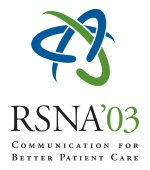Abstract:
HTML
Purpose: To assess the technical performance of a new digital slot-scan chest radiography system (ThoraScan) and to compare this with two techniques for screen-film radiography, i.e. Advanced Multiple Beam Equalization Radiography (AMBER) and wall bucky screen-film radiography (SFR).
Methods and Materials: The ThoraScan offers dose efficient scatter rejection through slot-scan technology and uses a relatively small array of charge-coupled device (CCD) detector elements to produce a large-area image. Consecutive image lines are acquired in a time-delay integration (TDI) mode. The Modulation Transfer Function (MTF) was measured along and perpendicular to the scan direction using a 0.2 mm-thick tungsten layer. A contrast-detail test object was used in combination with a phantom that simulates the primary and scatter transmission for lung-fields and mediastinum (LucAl). Phantom images of each modality were judged by six observers in a four-alternative-forced-choice experiment. Both hard copy and soft copy reading was performed for the ThoraScan. Contrast-detail curves were constructed from the observer data using a model based interpolation scheme to fit a curve through the observer data. The Wilcoxon signed-rank test was used for statistical analysis.
Results: In both the scan and slot direction the MTF's only differ slightly. The overall MTF is close to 0.7 at 1 cycle/mm and is roughly 0.35 at 2 cycles/mm, this is better than conventional film (Lanex Regular + TMG film). Contrast-detail results were statistically significant better with ThoraScan hardcopies than with Bucky radiographs for both the lung configuration (p = 0.001) and the mediastinum configuration (p = 0.03). No difference was found between ThoraScan hardcopies and AMBER radiographs for the lung configuration. For the mediastinum configuration, contrast-detail results were better with AMBER radiographs than with ThoraScan hardcopies (p = 0.01). When reading softcopies, better contrast-detail results were found with ThoraScan than with AMBER radiographs for the lung configuration (p = 0.001), whereas no significant difference was found between both systems in case of the mediastinum configuration.
Conclusion: From the MTF measurements equal or better image quality can be expected for the ThoraScan compared to screen-film radiography. ThoraScan's contrast-detail curves showed good image quality for the ThoraScan chest system when using hardcopies. Softcopy reading significantly improves the diagnostic potential of the system.
Questions about this event email: w.j.h.veldkamp@lumc.nl
Veldkamp MD, W,
Technical Performance of a New Digital Slot-Scan Chest Radiography System and Comparison with Screen-Film Chest Radiography through Assessment of the Modulation Transfer Function and Contrast Detail Performance. Radiological Society of North America 2003 Scientific Assembly and Annual Meeting, November 30 - December 5, 2003 ,Chicago IL.
http://archive.rsna.org/2003/3106461.html

